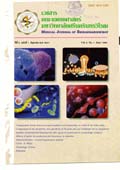Adrenomedullin:เปปไทด์ใหม่ที่มีผลลดความดันโลหิต
Keywords:
Adrenomedullin, ความดันโลหิตAbstract
adrenomedullin (ADM) เป็นเปปไทด์ใหม่ที่มีผลลดความดันโลหิต ซึ่งถูกค้นพบครั้งแรกในเนื้อเยื่อ pheochromocytoma ของคน นอกจากนี้ยังพบในเนื้อเยื่อและเซลล์อื่นๆอีกหลายชนิด ADM ประกอบด้วยกรดอะมิโน 52 ตัว พันธะไดซัลไฟด์ 1 พันธะภายในโมเลกุล และปลายคาร์บอกซิลที่มีหมู่ amide เปปไทด์นี้สามารถลดความดันเลือดแดงเฉลี่ยแบบ dose-dependent โดยการลดลงของความดันเลือดแดงเฉลี่ยจะสัมพันธ์กับการลดลงของความต้านทานรวม ซึ่งกลไกที่แน่นอนของ ADM ในการเกิดการคลายตัวของหลอดเลือดยังไม่ทราบแน่ชัด อย่างไรก็ตามจากการศึกษาที่ผ่านมาแสดงให้เห็นว่า ADM มีผลลดความโลหิตผ่านกลไก 2 ทาง คือกลไกหนึ่งเป็นผลโดยตรงที่เซลล์กล้ามเนื้อเรียบของหลอดเลือดในการเพิ่ม cAMP ภายในเซลล์ และอีกกลไกโดยการกระตุ้นเซลล์เยื่อบุหลอดเลือดให้หลั่งไนตริกออกไซด์ ซึ่งกลไกทั้งสองมีผลทำให้เกิดการคลายตัวของหลอดเลือด Adrenomedullin (ADM) is a novel hypotensive peptide discovered in human pheochromocytoma tissue. Moreover, it also found in variety tissues and cells. ADM consists of 52 amino acids,one intramolecular disulfide bond and carboxy-terminal amide. This peptide could decrease mean arterial pressure in a dose-dependent manner. This reduction in mean arterial pressure was correlated with a decrease in total peripheral resistance. The exact mechanism of ADM-induced vasorelaxation is not clear. However,several studies have demonstrated that ADM elicit the hypotensive effect through at least two machanisms, a direct action on vascular smooth muscle cells to increase intracellular cAMP and an action on endothelial cells to stimulate nltric oxide release, with both leading leading to vascular relaxation.Downloads
How to Cite
1.
เทพอารีนันท์ พ. Adrenomedullin:เปปไทด์ใหม่ที่มีผลลดความดันโลหิต. J Med Health Sci [internet]. 2008 Sep. 10 [cited 2026 Jan. 15];5(1). available from: https://he01.tci-thaijo.org/index.php/jmhs/article/view/61787
Issue
Section
Review article (บทความวิชาการ)



